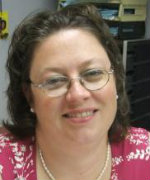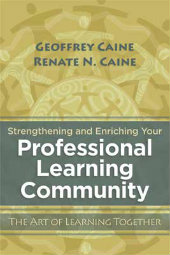Teacher-Led PD Circles
Strengthening and Enriching Your Professional Learning Community: The Art of Learning Together
By Geoffrey Caine and Renate N. Caine
(ASCD, 2010 – Learn more)
Too often, teachers tell stories of professional development sessions that turned out to be a waste of time. The reasons vary: a presenter’s unpreparedness, a lack of practical application, little relevancy to day-to-day teaching, and failure to achieve teacher buy-in on the topic. Fortunately, Geoffrey and Renate N. Caine have an answer for all of these issues: Process Learning Circles. Don’t let the word “circles” scare you: you won’t be holding hands and singing (probably). What Strengthening and Enriching Your Professional Learning Community: The Art of Learning Together will do is put the means for relevant, practical, thoughtful professional development back in your hands as the teacher.
Launching your Process Learning Circle
The Caines’ model is a specific form of professional learning community that they call a Process Learning Circle (PrLC). While the PrLC model does have some flexibility, the Caines recommend adhering to their research-based guidelines.
Groups of six to ten people volunteer to be a part of the PrLC for a minimum of one year, meeting for about two hours at least twice a month. Each meeting should have a designated leader familiar with the PrLC process, although the responsibility of leader may rotate throughout the group as the year goes on.
Most importantly, the group should come together ready to explore an educational question specific enough to give the group a single focus, yet broad enough to allow each member to find their own particular facet of the question to actively pursue. The Caines suggest “big issues” such as how people learn, improving test scores in general, or improving the teaching of math.
What a session looks like
Every PrLC session follows the same format: Ordered Sharing, Reflective Study, Commitment to Action and Action Research, and Regrouping (p. 37-38). These four phases allow every member of the group time to share thoughts on the topic, read/research/discuss the material that is the focus of the group, make a commitment to try one new thing in the classroom based on this research and discussion, and then reflect on what they have learned. Successive meetings build on this process, with the discussion phase allowing PrLC participants to share the results of their action research and develop further plans.
This book offers specific, example-filled chapters for each of the four phases of the meetings. Nine chapters are dedicated to how to conduct PrLCs, with additional chapters on dealing with individual differences, group dynamics, creating a field of listening, and more. You can easily and quickly read this book, as it is less than two hundred pages, and it is small enough to take to the meetings and use as a reference as needed. In fact, the Caines suggest perhaps forming a PrLC to study this book, in order to bring more teachers up to speed on the process and ready them to perhaps lead their own groups down the road.
Teacher buy-in, individual learning
The PrLC process outlined in this book has many positive outcomes. The circles are open to all staff in the building, which builds a sense of teamwork and camaraderie. Ordered sharing, in particular, helps participants develop a strong sense of community and deep listening skills. Since the groups are voluntary and topics are self-selected, teacher buy-in is already taken care of, which increases the likelihood of the committee’s work being successful.
The recursive process allows for deep thinking, significant and ongoing reflection, and best of all, a commitment to trying new things in the classroom. Aren’t these all qualities we try to bring into our classrooms already? How great would it be to model it for our students, as well? Finally, the strongest impact is seen in student achievement: as teachers teach with more innovation and reflection, students learn with greater depth and mastery.
A challenge well worth the effort
No true learning comes easily, and Process Learning Circles are no exception. To be successful, PrLCs require voluntary participation, significant time commitment, and a knowledgeable process leader. The good news? If you can find the teachers who want to improve, who want to do the best they can for each and every student, they will find the time. And if they can find the time, you can find this book and become the first PrLC leader in your building. This is definitely a process that I can see using at my middle school, and I think many readers in all levels of education will feel the same way.
Becky Osterfeld is a National Board Certified Teacher in Early Adolescence/English Language Arts. With a master’s degree in reading, Master Teacher endorsement, Lead Professional Educator certification, and fifteen years’ classroom experience, she enjoys constantly learning from others how to make each day better than the day before for both students and teachers. She teaches eighth grade Language Arts at a large public middle school in suburban Beavercreek, Ohio and loves every minute of it.



































